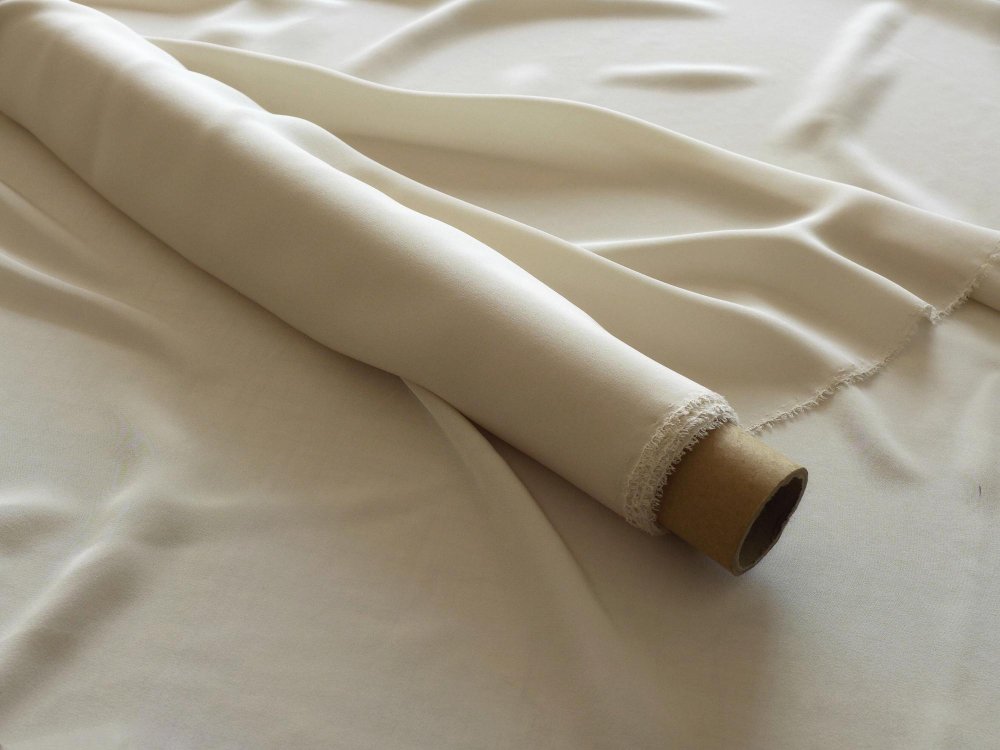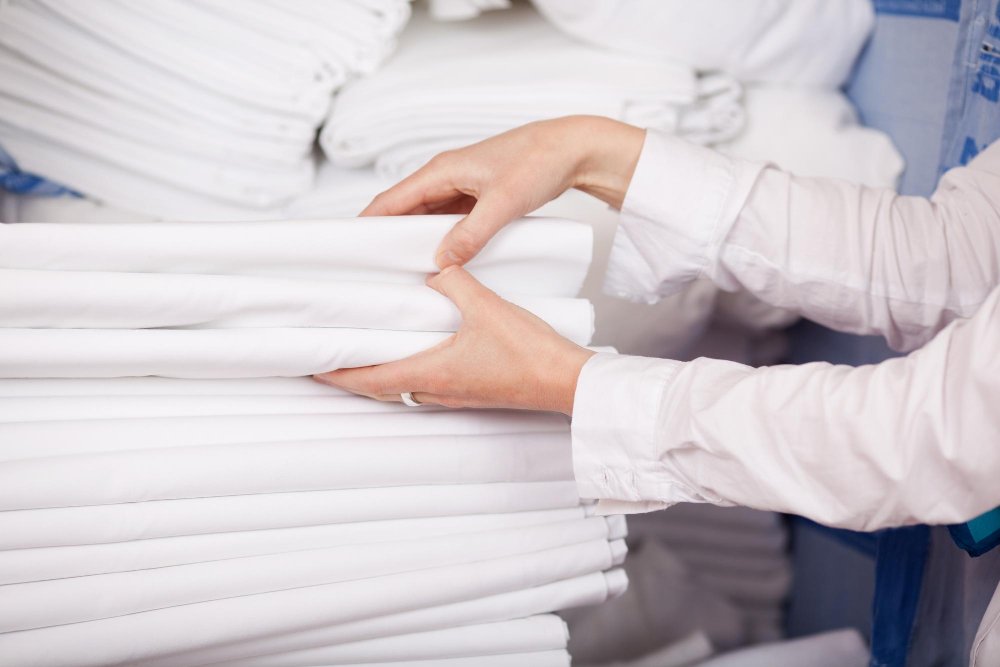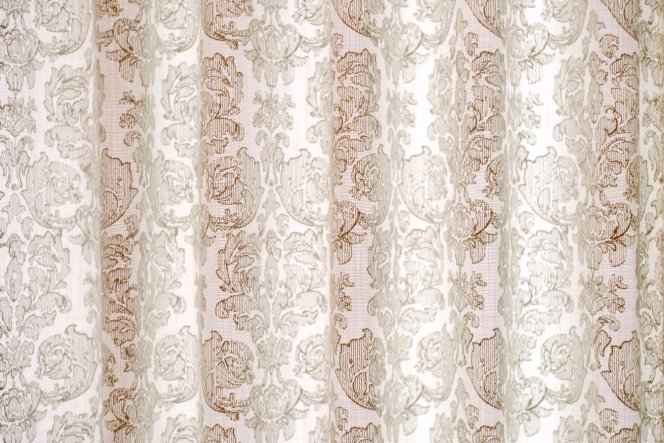An evidence-based look at linen bedding fabric, from fiber characteristics and production methods to practical tips for choosing and maintaining quality linen sheets
Quick Takeaways
- Linen sheets naturally regulate temperature, keeping you cool in summer and warm in winter
- High-quality linen becomes softer and more comfortable with each wash
- French and Belgian flax produce the world’s finest linen bedding
- Expect to invest $200-$600 for queen-size sets, but they can last 15-20 years
- Wash at 40°C (104°F) with mild detergent and skip the fabric softener
What’s Inside This Guide
What Is Sheeting Linen?
Sheeting linen refers to linen fabric that’s been woven specifically for bed sheets and bedding. Unlike the heavier linen used for tablecloths or curtains, sheeting linen is lighter and more flexible, making it perfect for wrapping yourself in at night.
The term “sheeting” simply means the fabric is designed and measured for making sheets. Think of it as linen that’s been optimized for comfort against your skin rather than durability for other household uses.
What Makes It Different from Regular Linen?
Sheeting linen typically weighs between 140-200 GSM (grams per square meter), which is lighter than the 200-400 GSM you’ll find in heavy-duty loose weave linen for other purposes. This lighter weight allows better airflow while you sleep.
Linen Weight Guide for Sheets
- Lightweight (140-160 GSM): Best for hot climates and summer
- Midweight (160-180 GSM): Year-round comfort for most climates
- Heavyweight (180-200 GSM): Winter warmth and colder regions
The Flax Plant Connection
All linen comes from the flax plant, which grows mainly in Europe. The fibers from the flax stem are spun into yarn, then woven into fabric. For sheeting linen, manufacturers use a plain weave or sometimes a closely woven pattern that creates a smooth, breathable surface.
Types and Quality Levels of Linen Sheets
Not all linen sheets are created equal. Understanding the different types helps you make a smart choice that fits your needs and budget.
European Flax: The Gold Standard
The best linen comes from Europe, specifically France and Belgium. These regions have the perfect climate and soil conditions for growing flax. When you see “100% European flax” or “French flax linen,” you’re looking at top-quality material.
European flax is certified by strict environmental standards. The plants need minimal water (rainfall is usually enough) and no pesticides, making this one of the most eco-friendly fabrics you can buy.
French vs Belgian Linen: What’s the Difference?
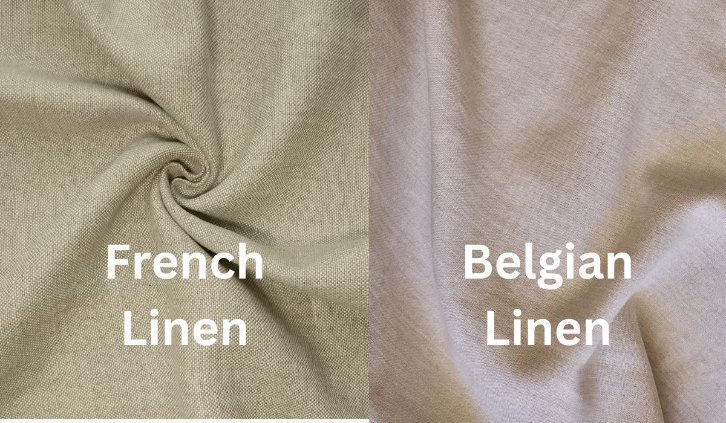
This is a common question, and honestly, the difference is minimal. Both France and Belgium produce exceptional linen. The quality depends more on the specific producer and how they process the flax than on which country it’s from.
Belgian linen has a reputation for being slightly crisper, while French linen is often described as a bit softer initially. But after a few washes, you won’t be able to tell them apart. Focus on the manufacturer’s reputation instead of the country of origin.
| Brand Type | Price Range (Queen) | Material Source | Best For | Expected Lifespan |
|---|---|---|---|---|
| Budget-Friendly | $100-$200 | Mixed origin, linen blends | First-time buyers, guest rooms | 5-8 years |
| Mid-Range | $200-$400 | European flax, good finishing | Daily use, balanced quality | 10-15 years |
| Premium | $400-$600+ | French/Belgian flax, stonewashed | Luxury comfort, investment piece | 15-20+ years |
Stonewashed vs Regular Linen
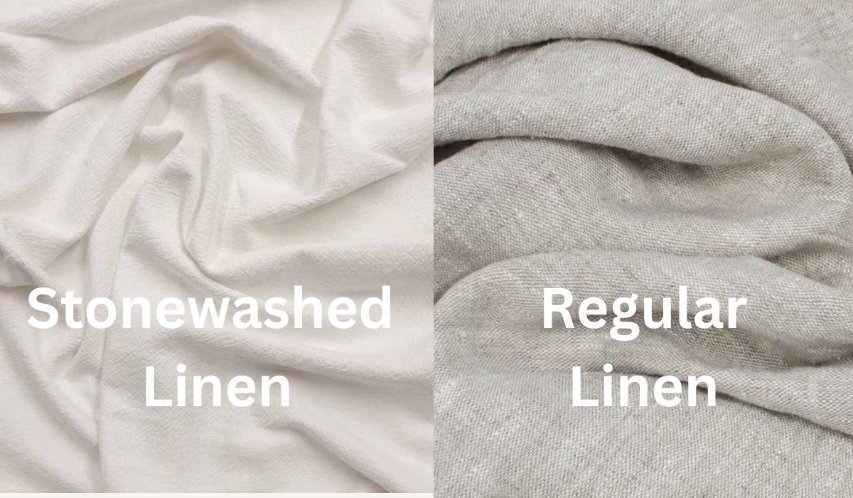
Stonewashed linen has been tumbled with stones (or similar materials) during manufacturing to soften the fibers. This process gives you that soft, lived-in feel right out of the package. Regular linen starts out crispier and softens naturally over time with washing.
If you want immediate softness, go with stonewashed. If you don’t mind waiting a few washes and prefer to save some money, regular linen is fine. Both end up wonderfully soft eventually.
Linen Blends: Are They Worth It?
You’ll often see cotton-linen blends, typically 50/50 or 70/30 ratios. These combine cotton’s immediate softness with linen’s temperature regulation and durability.
✓ Pros of Linen Blends
- Softer from day one
- Less wrinkling
- Lower price point
- Easier to iron if needed
✗ Cons of Linen Blends
- Less breathable than pure linen
- Won’t last as long
- Loses some of linen’s unique texture
- May not regulate temperature as well
Why Choose Linen Sheets Over Cotton or Synthetic
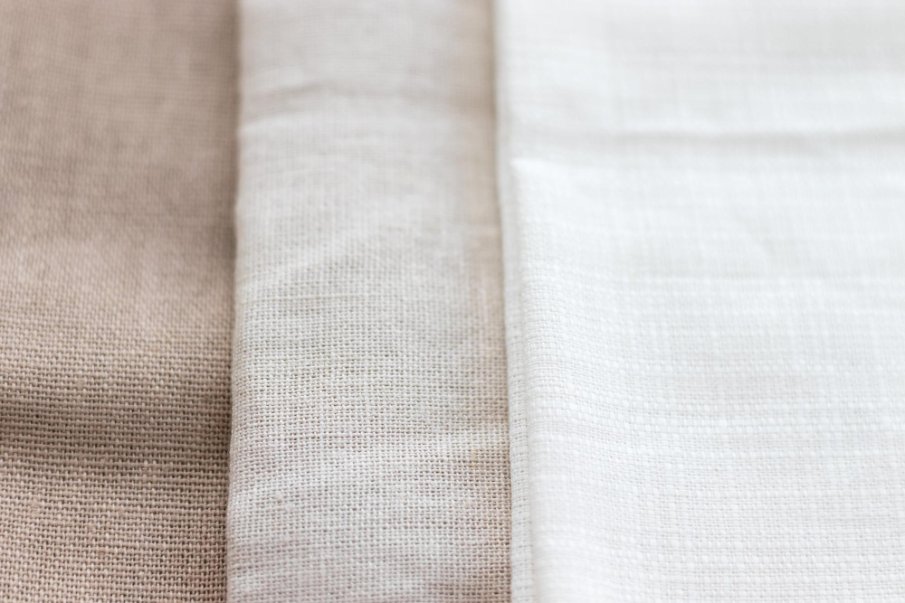
Linen sheets offer benefits that cotton and polyester simply can’t match. Here’s what makes them special.
Temperature Regulation That Actually Works
The hollow fibers in linen create natural air pockets that adapt to your body temperature. In summer, they allow heat to escape and wick away moisture. In winter, those same fibers trap warmth close to your body.
This isn’t marketing talk. Linen can absorb up to 20% of its weight in moisture before feeling damp. That’s why you’ll stay dry even if you’re a sweaty sleeper. Cotton poplin and sateen cotton sheets absorb moisture too, but they hold onto it longer, which can make you feel clammy.
Durability: The 20-Year Sheet
Linen fibers are three times stronger than cotton fibers. With proper care, a quality set of linen sheets can easily last 15-20 years, getting softer and more comfortable with each wash.
Compare that to cotton sheets, which typically need replacing every 2-3 years, or polyester sheets that start pilling after a year. When you do the math, linen is actually cheaper over time despite the higher upfront cost.
How Linen Gets Better With Age
This is the magic of linen. Every wash breaks down the natural pectin in the fibers, making them softer and more pliable. After 10-15 washes, your sheets will feel completely different from when you first bought them, and that’s a good thing.
The texture becomes buttery soft while maintaining its strength. Think of it like a good pair of jeans that get more comfortable over time. Cotton just wears out. Linen transforms.
Health Benefits of Sleeping on Linen
Are linen sheets healthier than cotton sheets? The short answer is yes, for several reasons.
Natural Antibacterial Properties
Linen is naturally antibacterial and resistant to fungi and bacteria. This means your sheets stay fresher longer between washes, and you’re less likely to deal with odors or allergens building up in the fabric.
Hypoallergenic and Gentle
If you have sensitive skin or allergies, linen is one of the best choices. It’s non-irritating and actually gets gentler over time. The fabric doesn’t hold onto dust mites or allergens the way synthetic fabrics do.
Hospitals used to rely heavily on linen sheets because of these properties. They stopped mainly due to cost and the time required for proper laundering, not because linen wasn’t superior.
Better Sleep Quality
Studies show that temperature regulation is one of the biggest factors in sleep quality. Since linen keeps you at a comfortable temperature all night, you’re less likely to wake up too hot or too cold.
Is It Healthy to Sleep on Linen Sheets?
Yes. Linen sheets offer these health benefits:
- Reduce night sweats and hot flashes
- Minimize allergen exposure
- Prevent bacterial growth
- Keep skin hydrated (doesn’t absorb moisture from your skin)
- Support better sleep through temperature control
How to Choose Quality Linen Sheets
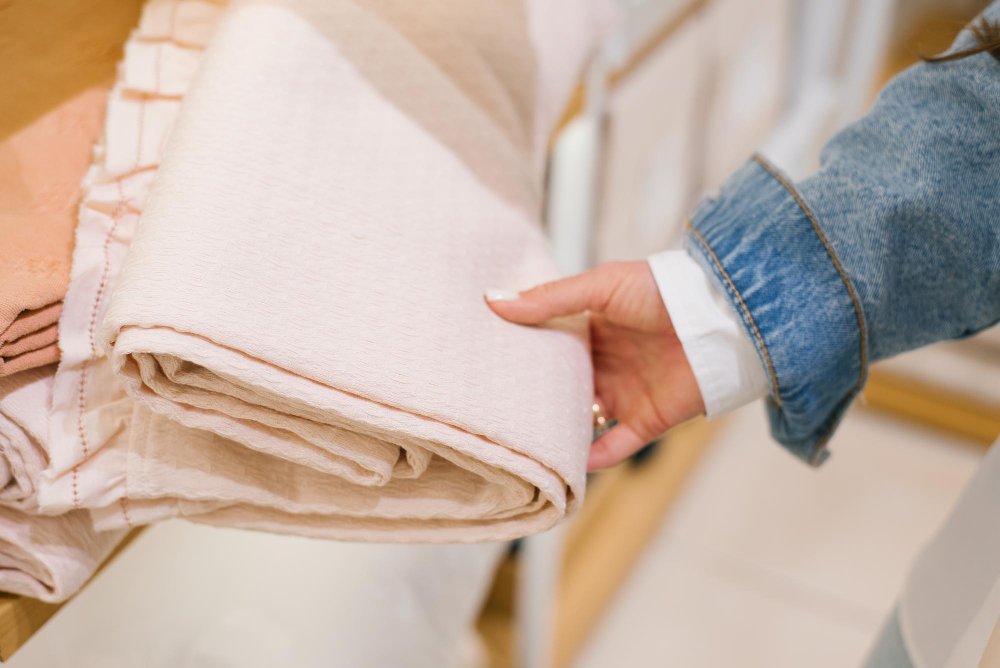
Shopping for linen sheets can feel overwhelming with all the options out there. Here’s how to identify quality without getting tricked by marketing.
What to Look For
1. Fabric Composition
Look for “100% linen” or “100% European flax” on the label. If it just says “linen” without percentages, it might be a blend. Blends aren’t bad, but you should know what you’re buying.
2. Weight (GSM)
Quality linen sheets typically range from 140-200 GSM. Anything below 130 GSM might be too thin and wear out quickly. Above 220 GSM and you’re getting into tablecloth territory. That’s too heavy for comfortable sleeping.
3. Finishing Quality
Check the edges and seams. Good linen sheets have:
- Clean, straight hems
- No loose threads
- Even stitching
- Reinforced corners on fitted sheets
4. Color Consistency
Natural linen has slight variations in color, and that’s normal and part of its charm. But the variations should be subtle and evenly distributed, not patchy or streaky.
Understanding Linen Grades
While linen doesn’t use “thread count” like cotton, there are still quality grades:
Grade A (Premium): Made from the longest flax fibers, with minimal slubs (those little bumps in the fabric). Smooth texture, even weave.
Grade B (Standard): Uses shorter fibers, more visible slubs. Still durable and comfortable, just not as refined.
Grade C (Economy): Shorter fibers, inconsistent weave. Acceptable quality but won’t last as long or feel as nice.
Certifications That Matter
Look for these certifications when shopping:
- OEKO-TEX Standard 100: Guarantees no harmful chemicals in the fabric
- European Flax Certification: Confirms the linen is from certified European flax
- GOTS (Global Organic Textile Standard): For organic linen, ensures eco-friendly processing
🎯 Find Your Perfect Linen Match
Not sure which weight and type of linen is right for you? Use our interactive selector to get personalized recommendations based on your climate, preferences, and budget.
Take the Linen QuizLinen vs Cotton vs Synthetic: The Real Differences
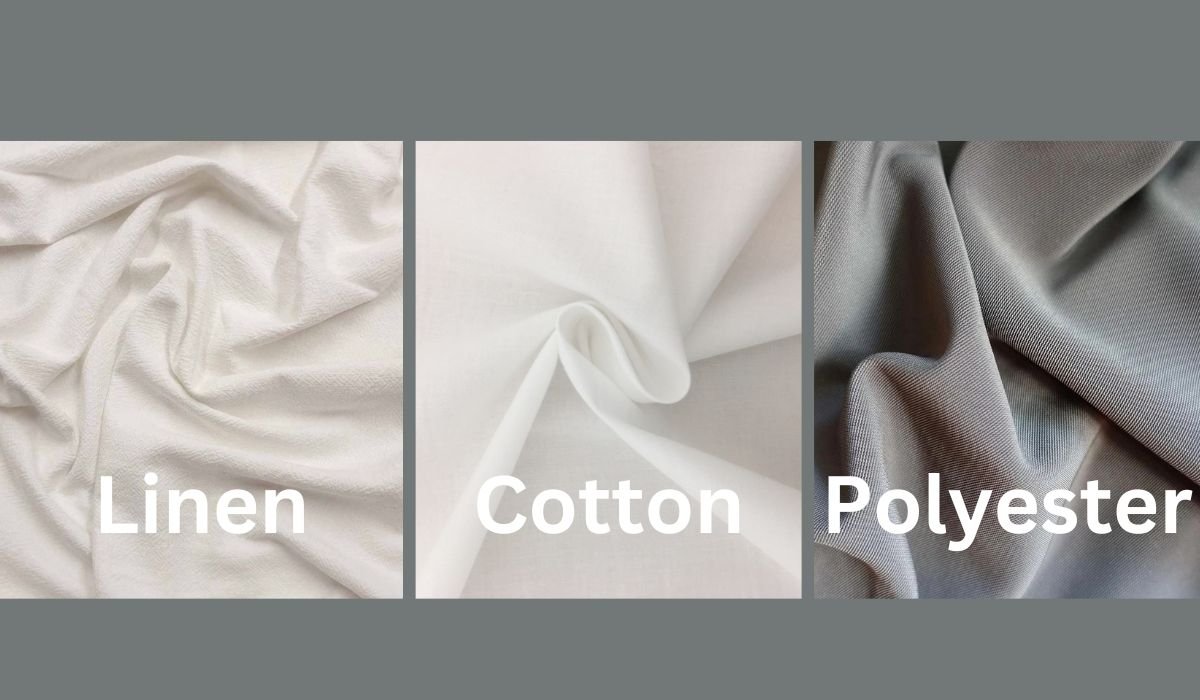
Let’s break down how linen compares to your other bedding options. This will help you decide if linen is worth the investment for your situation.
| Feature | Linen | Cotton | Synthetic (Polyester/Microfiber) |
|---|---|---|---|
| Breathability | Excellent – Best airflow | Good – Depends on weave | Poor – Traps heat |
| Moisture Wicking | Superior – Absorbs 20% of weight | Good – Absorbs but holds moisture | Poor – Doesn’t absorb well |
| Durability | 15-20+ years | 2-3 years | 1-2 years |
| Softness | Improves over time | Soft initially, degrades | Soft but pills quickly |
| Price (Queen Set) | $200-$600 | $50-$300 | $30-$100 |
| Care Difficulty | Easy – Wash and go | Easy – May need ironing | Very easy |
| Wrinkles | Wrinkles naturally (it’s part of the look) | Can be crisp or wrinkle depending on type | Usually wrinkle-resistant |
| Environmental Impact | Low – Renewable, biodegradable | Medium – Needs pesticides/water (unless organic) | High – Petroleum-based, sheds microplastics |
Is It Better to Sleep on Cotton or Linen?
The answer depends on your priorities:
Choose linen if you:
- Sleep hot or have night sweats
- Want sheets that last decades
- Prefer natural, eco-friendly materials
- Don’t mind the natural wrinkled texture
- Can invest upfront for long-term value
Choose cotton if you:
- Prefer immediate softness
- Like crisp, smooth sheets (like Egyptian cotton)
- Have a tighter budget
- Want more color and pattern options
- Prefer sheets that don’t wrinkle as much
Why Is 100% Linen So Expensive?
There are legitimate reasons linen costs more:
- Labor-Intensive Production: Processing flax into linen takes more steps than cotton. The plant must be harvested, retted (a fermentation process), scutched, and hackled before it can be spun.
- Limited Growing Regions: Quality flax only grows well in specific European climates, limiting supply.
- Lower Yield: Flax plants produce less usable fiber per acre than cotton.
- Skilled Manufacturing: Weaving linen properly requires more expertise than cotton.
But remember: you’re buying sheets that will last 10-15 times longer than cheap cotton or synthetic options. Divide that $400 price tag by 15 years, and you’re spending about $27 per year. Suddenly it doesn’t seem so expensive.
Care Instructions That Actually Work
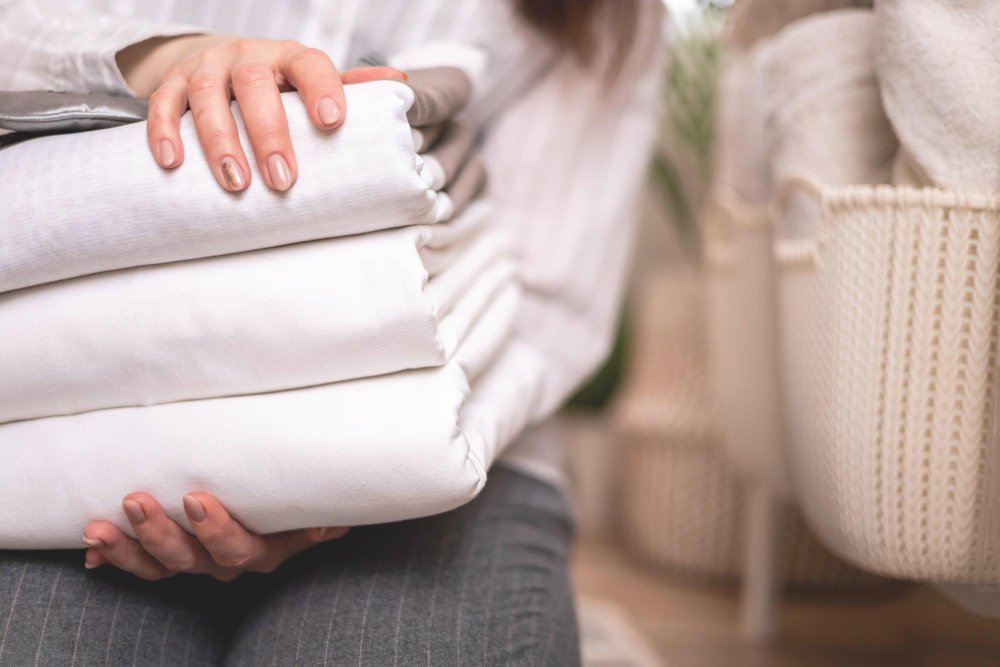
Here’s the good news: linen is way easier to care for than its reputation suggests. You don’t need to baby it or take it to the dry cleaner. Follow these simple rules and your sheets will last for years.
Washing Your Linen Sheets
Check the Label
Always read manufacturer instructions first. Most linen can handle 40°C (104°F).
Separate Colors
Wash light and dark colors separately, especially for the first few washes.
Use Mild Detergent
Skip harsh chemicals and fabric softener. Linen doesn’t need them.
Don’t Overload
Keep the machine 3/4 full so sheets can move freely.
Gentle Cycle
Use a gentle or normal cycle. No need for anything aggressive.
Extra Spin
Add an extra spin cycle to remove excess water. Linen holds moisture.
Detailed Washing Instructions
Water Temperature: Warm water (40°C/104°F) works best for most linen. Cold water is fine for lightly soiled sheets. Avoid hot water. It can make linen stiff and may cause shrinkage.
Detergent Type: Use a mild liquid detergent without optical brighteners or bleach. These chemicals can weaken linen fibers and cause yellowing over time. Natural, biodegradable detergents work great.
Fabric Softener: Never use it. Linen naturally softens with each wash. Fabric softener coats the fibers and actually makes them less absorbent and breathable.
Can Linen Sheets Go in the Dryer?
Yes, but with caution. Here’s the smart way to dry linen:
Best Method (Low Heat):
- Tumble dry on low heat for 10-15 minutes
- Remove while still slightly damp
- Hang or lay flat to finish air drying
This method prevents over-drying and wrinkles while still making use of your dryer. The key is removing the sheets before they’re completely dry.
Alternative Method (Air Dry): Hang sheets on a line or drying rack. They’ll be a bit crisper this way but will soften up on your bed. Line drying outdoors gives linen a fresh, clean smell.
What to Avoid: High heat drying can cause excessive wrinkling and make linen feel rough. It may also cause some shrinkage.
Dealing With Wrinkles
Let’s address the elephant in the room: yes, linen wrinkles. That’s part of its character. But if you really can’t stand wrinkles, here are your options:
The Lazy Way (Recommended): Make your bed while the sheets are still slightly damp from the dryer. The weight of your comforter and pillows will smooth out most wrinkles as they finish drying.
The Iron Way: If you must iron, do it while the linen is still damp on medium heat. Iron on the reverse side of dark colors to prevent shine marks.
The Steam Way: Use a garment steamer for a quick touch-up. This is gentler than ironing and faster.
The Real Talk: Most linen lovers embrace the wrinkles. They’re part of what makes linen look relaxed and lived-in. Once you get used to it, perfectly smooth sheets might even look too formal.
Stain Removal for Linen
Act fast when spills happen:
- Blot (don’t rub) the stain immediately
- Mix baking soda with a few drops of water to make a paste
- Apply to the stain and let sit for 15 minutes
- Rinse with cool water
- Wash as normal
For tough stains like red wine or blood, add a few drops of white vinegar to the baking soda paste. For oil-based stains, use a tiny drop of mild dish soap.
How Often Should You Wash Linen Sheets?
Wash your sheets every 1-2 weeks for normal use. If you sweat heavily, have allergies, or sleep with pets, wash weekly.
The good news: linen’s natural antibacterial properties mean it stays fresher longer than cotton. You might be able to stretch to two weeks comfortably, whereas cotton sheets usually need weekly washing.
📅 Get Your Personalized Care Schedule
Not sure how often to wash your linen based on your lifestyle? Our calculator takes into account your climate, usage, and preferences to create a custom care schedule.
Create My Care PlanStoring Linen Sheets
Proper storage keeps your sheets fresh between uses:
- Store in a cool, dry place away from direct sunlight
- Use a breathable cotton bag or pillowcase, not plastic
- Avoid cramming too many sheets together. Linen needs air circulation
- Rotate sets regularly if you have multiple to prevent yellowing
- Keep away from perfumes or strong scents that can penetrate the fibers
How to Make a Bed with Linen Sheets
Properly making a bed with linen sheets can improve their appearance and help maintain that crisp, professional look. This video demonstrates the traditional hospital corner technique, which works particularly well with linen bedding:
Your Linen Buying Guide: Match Sheets to Your Needs
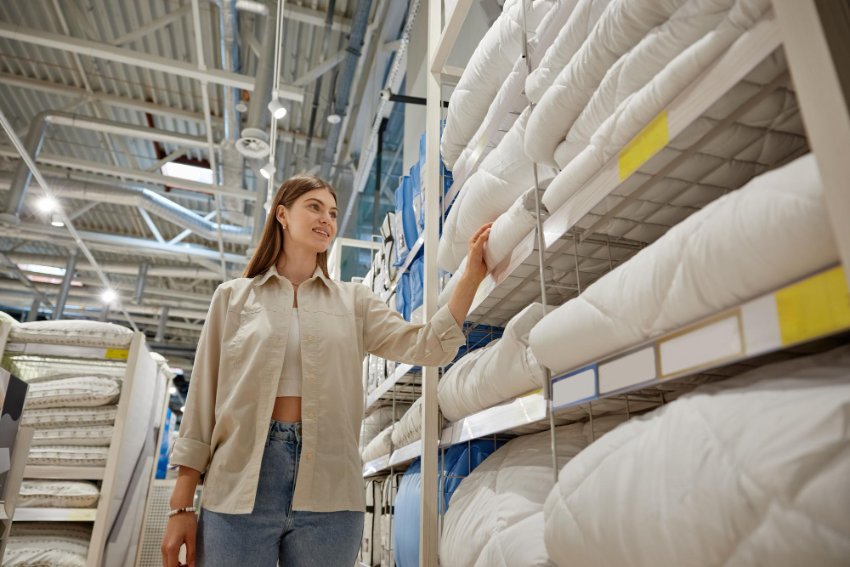
Let’s get specific about which linen sheets work best for different situations. This will help you narrow down options and avoid buyer’s remorse.
Best Linen for Hot Sleepers
If you wake up sweaty or throw off covers at night:
- Weight: 140-160 GSM (lightweight)
- Color: White, cream, or light colors that don’t absorb heat
- Weave: Loose weave for maximum airflow
- Finish: Stonewashed for immediate comfort
Look for sheets specifically marketed for “summer” or “warm climates.” The lighter weight makes a real difference in temperature regulation.
Best Linen for Cold Climates
For chilly nights and winter use:
- Weight: 180-200 GSM (heavyweight)
- Color: Any (darker colors add psychological warmth)
- Weave: Closely woven to trap heat
- Finish: Regular linen (crispness adds structure and warmth)
Pair heavyweight linen with a warm duvet for the best winter sleep experience. The linen will still regulate moisture, preventing that clammy feeling you get with synthetic sheets.
Best Budget-Friendly Options
Want to try linen without breaking the bank?
- Start with pillowcases ($30-$60 per pair) to test if you like linen
- Consider cotton-linen blends (50/50 or 70/30) for lower prices
- Buy during sales – many retailers offer 20-30% off seasonally
- Look for direct-to-consumer brands that skip retail markups
You can find decent linen sets for $150-$250 if you shop smart. They might not be premium French flax, but they’ll still outlast cotton sheets by years.
Best Premium Investment Pieces
Ready to invest in the best?
- Material: 100% French or Belgian flax
- Finish: Stonewashed for immediate luxury
- Certification: OEKO-TEX and European Flax certified
- Construction: Double-stitched hems, reinforced corners
Premium sets ($400-$600) often come with better packaging, longer warranties, and superior customer service. Some brands offer try-before-you-buy periods.
Best for Sensitive Skin
If you have eczema, allergies, or sensitive skin:
- Choose OEKO-TEX certified linen (guarantees no harmful chemicals)
- Opt for undyed or naturally dyed options
- Look for “organic linen” or GOTS certified
- Avoid bright colors that require heavy dyes
- Wash 2-3 times before first use to remove any remaining processing residues
Best All-Around Choice
If you want one set that works year-round:
- Weight: 160-180 GSM (midweight)
- Material: 100% European flax
- Finish: Stonewashed
- Color: Neutral (white, cream, light gray)
- Price: $250-$400
This combination works well in most climates and situations. You can always add a blanket for extra warmth or use just the sheet in summer.
🎨 Find Your Perfect Color
Not sure which linen color will match your bedroom? Use our color matching tool to see which shades work best with your existing decor.
Match My ColorsWhat About Fitted Sheet Depth?
Most linen fitted sheets accommodate mattresses up to 15 inches deep. If you have a thick mattress (over 16 inches) or use a topper:
- Look for “deep pocket” linen sheets (16-18 inches)
- Check the listed pocket depth before buying
- Some brands offer “extra deep” options for pillow-top mattresses
Too-shallow fitted sheets are frustrating. They pop off corners during the night and wear out faster from the constant tension.
Your Questions About Linen Sheets Answered
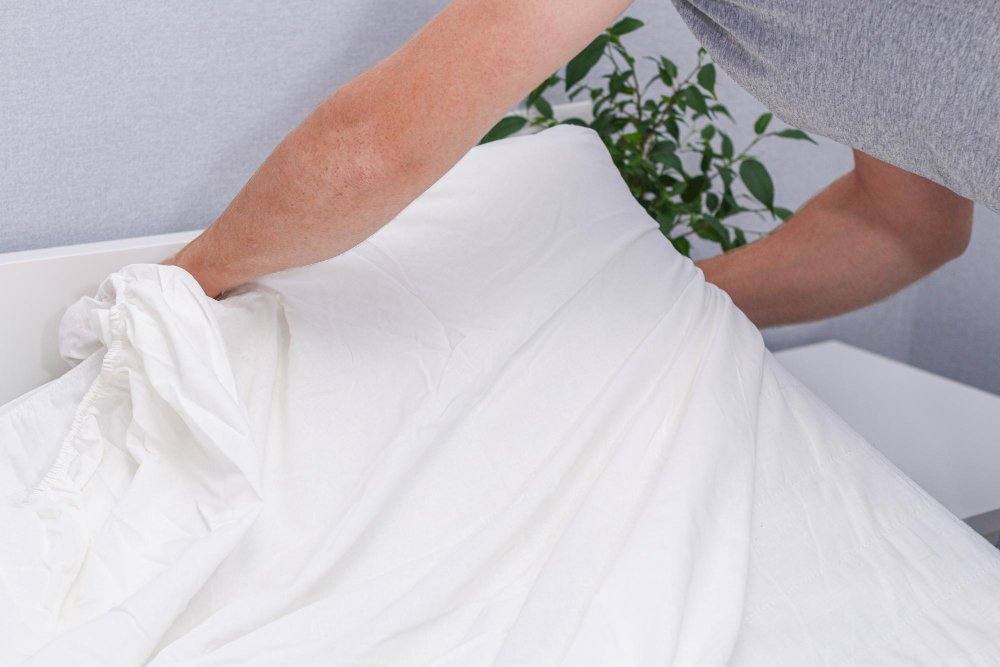
Linen sheets are among the healthiest options because they’re naturally antibacterial, hypoallergenic, and allow excellent breathability. They don’t trap moisture or bacteria the way synthetic materials do. For people with allergies or sensitive skin, organic linen certified by GOTS is the healthiest choice since it’s free from pesticides and chemical processing.
French and Belgian flax linen are considered the highest quality in the world. These regions produce European Flax certified linen, which meets strict environmental and quality standards. Irish linen also has an excellent reputation, though production is more limited. The best quality comes down to specific manufacturers rather than country – look for brands using long-fiber flax and traditional production methods.
Hospitals phased out linen sheets mainly for cost reasons. While linen is superior in terms of hygiene and durability, it requires more time to wash and iron properly. Cotton-polyester blends became popular because they’re cheaper, dry faster, resist wrinkles, and can withstand the harsh, high-temperature sanitizing cycles hospitals use. It wasn’t because linen performed poorly – it was purely an economic decision.
Yes, linen sheets are excellent for most people. They regulate temperature better than cotton or synthetic options, last 10-15 times longer, and become softer with every wash. The main downsides are the higher upfront cost and natural wrinkling. If you sleep hot, value durability, or want sustainable bedding, linen sheets are worth the investment. They’re particularly good for hot sleepers who struggle with night sweats.
Australians call bedding “Manchester” because of the city Manchester, England, which was the world’s leading textile manufacturing center in the 1800s. During colonial times, quality linens, sheets, and towels were imported from Manchester mills. The term stuck in Australia and New Zealand even though Manchester is no longer the primary source of bedding materials.
Yes, this is one of linen’s best features. Every wash breaks down the natural pectin in the fibers, making them progressively softer and more comfortable. After 10-15 washes, linen sheets feel completely transformed – buttery soft while maintaining their strength. This is opposite to cotton sheets, which start soft but gradually break down and thin out over time.
With proper care, quality linen sheets can last 15-20 years or more. You typically won’t need to replace them unless they develop holes or you want a style change. This longevity is why the higher upfront cost makes sense – divide $400 by 15 years and you’re paying less than $30 per year for bedding that gets better with age.
Sheeting is a category of fabric woven specifically for making sheets and bedding. It’s lighter and more flexible than fabric used for upholstery or drapery. Sheeting can be made from various materials – cotton sheeting (like poplin or sateen), linen sheeting, or synthetic materials. The term just indicates the fabric is designed for bed linens rather than other uses.
Absolutely. Despite common myths, linen is machine washable and quite durable. Use a gentle or normal cycle with warm water (40°C/104°F), mild detergent, and avoid fabric softener. Linen actually becomes easier to care for over time as the fibers soften. There’s no need for dry cleaning or hand washing unless specifically stated on the care label.
Linen fell out of favor in commercial settings mainly due to cost and the rise of cheaper alternatives. Polyester satin and cotton-poly blends are cheaper to produce and easier to maintain at industrial scale. However, linen is making a comeback in home bedding as people value its sustainability, durability, and natural properties over synthetic alternatives.
Understanding Different Linen Terms
There’s no definitive answer – both produce excellent linen. The quality depends more on the specific manufacturer and their processing methods than the country. Belgian linen tends to have a reputation for being slightly crisper initially, while French linen is sometimes described as softer from the start. After several washes, you won’t be able to tell them apart. Focus on certifications and manufacturer reputation instead of country of origin.
Yes, 100% European flax is the gold standard for linen quality. European Flax certification ensures the linen comes from Western Europe (primarily France, Belgium, and the Netherlands) where ideal growing conditions and strict environmental standards produce the finest quality flax. European flax requires minimal water and no pesticides, making it one of the most eco-friendly fabrics available.
The best linen for sheets is 100% European flax in midweight (160-180 GSM) with a stonewashed finish. This combination gives you immediate comfort, year-round usability, and long-term durability. If you sleep hot, go lighter (140-160 GSM). For cold climates, choose heavier (180-200 GSM). Avoid anything marketed as “linen blend” unless you specifically want the characteristics of mixed materials.
More Practical Questions
Advantages: Temperature regulation, moisture-wicking, antibacterial, hypoallergenic, gets softer over time, lasts 15-20 years, eco-friendly, and low maintenance. Disadvantages: Higher upfront cost ($200-$600), wrinkles naturally, starts out crisp (if not stonewashed), limited color options compared to cotton, and can feel rough initially if you’re used to cotton.
Archaeological evidence suggests humans started using blankets and bedding materials around 77,000 years ago. Early blankets were made from animal skins and plant fibers. Woven textiles for bedding emerged around 5,000-7,000 years ago. Linen bedding specifically dates back to ancient Egypt (around 5,000 years ago), where it was so valued that it was used as currency and found in pharaohs’ tombs.
Sheeting fabric is primarily used for bed linens – fitted sheets, flat sheets, pillowcases, and duvet covers. It’s also used for lightweight clothing like summer dresses and shirts. The key characteristic is that it’s lighter and more flexible than fabric used for upholstery, curtains, or heavy-duty applications. Different materials like cotton, linen, or blends can be made into sheeting fabric.
Understanding Linen Sheet Construction
The way linen sheets are made affects their feel, durability, and price. Here’s what you need to know about construction quality.
Weave Types in Linen Sheeting
Most linen sheets use a plain weave (also called tabby weave), where threads cross over and under each other in a simple pattern. This creates a balanced, durable fabric that breathes well.
Some specialty linen uses a damask weave, which creates patterns in the fabric. This is prettier but doesn’t affect performance much.
What About Linen Thread Count?
Here’s the thing: linen doesn’t use thread count the way cotton does. The fibers are naturally thicker, so you’ll never see “800-thread-count linen sheets” because it’s physically impossible with linen’s fiber size.
Instead, focus on GSM (grams per square meter) for linen. This tells you the weight and density of the fabric, which is more relevant than thread count for linen quality.
Hem Quality Matters
Check how the edges are finished. Quality linen sheets have:
- Double-fold hems (the edge is folded twice before stitching)
- Even, straight stitching with no loose threads
- Reinforced corners on fitted sheets
- Neat mitered corners (45-degree angles at pillowcase corners)
Poor hem quality is often the first thing to fail on cheaper sheets. If corners start fraying after a few washes, the whole sheet won’t last long.
Sustainable and Ethical Considerations
If you care about environmental impact, linen is one of the best choices you can make. Here’s why.
Why Linen Is Eco-Friendly
The flax plant requires:
- Almost no irrigation (rainfall is usually sufficient)
- No pesticides (flax is naturally pest-resistant)
- No fertilizers in most cases
- Every part of the plant gets used – nothing goes to waste
Compare this to cotton, which uses massive amounts of water and pesticides, or synthetic fabrics made from petroleum. Linen is about as low-impact as textiles get.
Linen Is Biodegradable
When your linen sheets finally wear out (in 15-20 years), they’ll decompose naturally. They won’t sit in a landfill for decades like polyester sheets, and they won’t shed microplastics into waterways like microfiber fabrics.
Fair Labor Practices
Many European linen manufacturers maintain fair labor practices and transparent supply chains. Look for brands that:
- Manufacture in Europe (France, Belgium, Portugal, Lithuania)
- Are transparent about their production facilities
- Have certifications like OEKO-TEX or European Flax
- Support small, family-owned mills
Conclusion
The Bottom Line on Linen Sheets
After covering everything from fabric construction to care instructions, let’s summarize what you need to know to make a smart decision about linen sheets.
Linen Sheets Are Worth It If You:
- Sleep hot or struggle with night sweats – linen’s temperature regulation is unmatched
- Value long-term investment over short-term savings – they last 10-15 times longer than cotton
- Care about environmental impact – linen is one of the most sustainable fabrics
- Appreciate natural materials and textures – the slightly textured feel is part of the appeal
- Don’t mind the natural wrinkled look – or can embrace it as part of linen’s character
- Have sensitive skin or allergies – the antibacterial and hypoallergenic properties help
Consider Alternatives If You:
- Prefer perfectly smooth, wrinkle-free sheets – cotton blends or microfiber might suit you better
- Can’t invest more than $100 in a sheet set – try cotton-linen blends first
- Want immediate softness without any break-in period – sateen cotton or satin weave fabrics start softer
- Need frequent style changes – linen’s limited color range and high cost make frequent updates expensive
Top Takeaways
- Start with pillowcases: If you’re unsure about committing to a full set, buy linen pillowcases first ($30-60). This lets you test how linen feels against your skin without the full investment.
- Buy quality once: It’s better to save up for one good set ($300-400) than to buy cheap linen ($100-150) that won’t last. The price difference per year of use is minimal.
- Choose midweight for versatility: Unless you have specific climate needs, 160-180 GSM linen works year-round for most people. You can always add blankets for warmth.
- Don’t overthink colors: Neutral colors (white, cream, natural) are popular because they match everything and show quality better than dark colors. They’re also easier to care for.
- Care is simpler than you think: Wash at 40°C, use mild detergent, skip fabric softener, tumble dry on low and remove while damp. That’s it. No special treatment needed.
- Accept the wrinkles: Linen wrinkles naturally. This is not a defect – it’s a feature. Once you stop fighting it and embrace the relaxed look, you’ll actually prefer it to overly crisp sheets.
- The first wash matters: Always wash new linen sheets 2-3 times before judging them. They start out crisp and get better with each wash. Don’t return them after the first night.
- Buy from reputable sources: With linen’s popularity, there are many cheap imitations. Stick to brands that offer certifications, clear material descriptions (100% European flax), and good return policies.
Your Action Plan
Step 1: Determine your budget and must-have features (weight, color, stonewashed vs regular).
Step 2: Research 3-5 brands in your price range. Read recent reviews (within the last year) and check their return policies.
Step 3: Order during a sale if possible. Many brands offer 20-30% off seasonally. Sign up for newsletters to catch these deals.
Step 4: When your sheets arrive, wash them 2-3 times before making a final judgment. Linen needs this break-in period.
Step 5: Give yourself a month to adjust. If you’re coming from cotton or synthetic sheets, linen feels different. Most people grow to love it once they adapt.
Common Mistakes to Avoid
- Buying too cheap: Linen under $120 for a queen set is usually poor quality and won’t last
- Using fabric softener: This coats the fibers and ruins linen’s natural properties
- Over-drying: Remove from dryer while slightly damp to prevent excessive wrinkling
- Expecting cotton-like softness immediately: Linen starts crisp (unless stonewashed) and improves
- Buying the wrong weight: Too light feels flimsy, too heavy feels stiff – match to your climate
- Ignoring certifications: OEKO-TEX and European Flax certifications matter for quality assurance
The Real Cost Analysis
Let’s do the math on why linen makes financial sense:
Quality Linen Sheets ($400 for queen set):
Lifespan: 15 years
Cost per year: $26.67
Cost per month: $2.22
Mid-Range Cotton Sheets ($100 for queen set):
Lifespan: 2-3 years
Sets needed over 15 years: 5-7 sets = $500-700
Cost per year: $33-47
Cost per month: $2.75-3.92
Over 15 years, you’ll spend less on quality linen than replacing cotton sheets multiple times. Plus, the linen keeps getting better while cotton degrades.
Final Thoughts
Linen sheets are one of those purchases where spending more upfront genuinely pays off. They’re not just bedding – they’re an investment in better sleep, reduced environmental impact, and long-term value.
The transition to linen might take a few weeks as you adjust to the different texture, but most people report they can’t go back to cotton once they experience linen’s temperature regulation and improving softness.
If you’re still on the fence, start small with pillowcases or consider a cotton-linen blend. But if you’re ready to commit, buy the best quality you can afford. Your future self (and your sleep quality) will thank you.
🧮 Calculate Your Linen Investment
Use our cost calculator to compare the long-term value of linen sheets versus cotton or synthetic options based on your usage patterns and budget.
Calculate Long-Term ValueExternal Resources for Further Reading
For more information about linen and textile quality, these authoritative sources provide additional details:
- Masters of Linen – The official European Flax certification body with detailed information about linen production and sustainability
- OEKO-TEX Standard 100 – Information about textile safety certifications and what they mean for your health
- ScienceDirect: Flax Fiber Properties – Scientific research on linen fiber characteristics and performance
Ready to upgrade your sleep with premium linen sheets? Use the guides and tools above to find your perfect match and start enjoying bedding that gets better with every single night.

